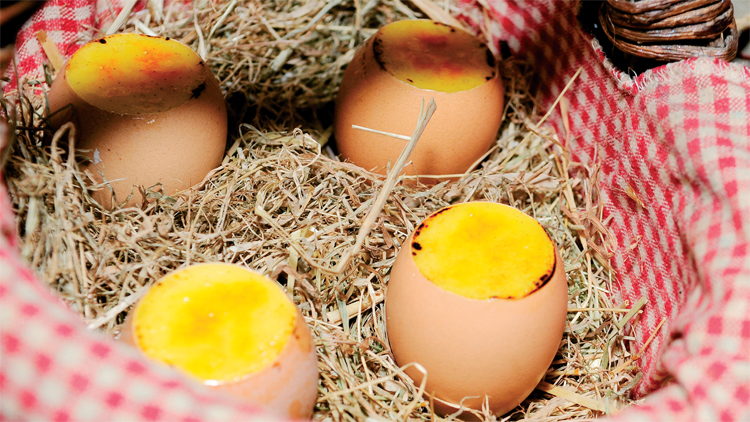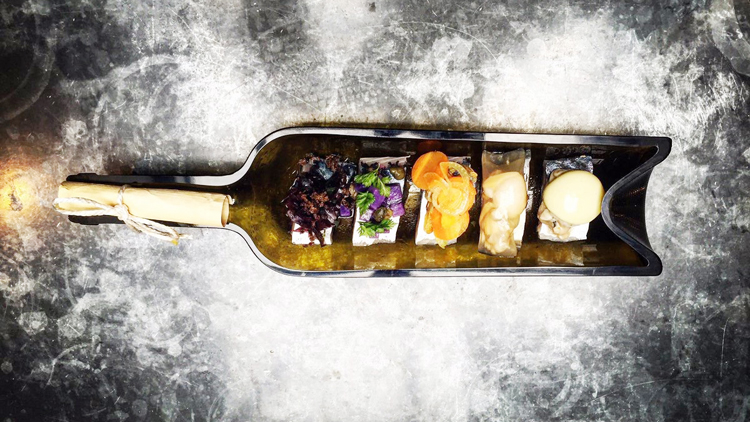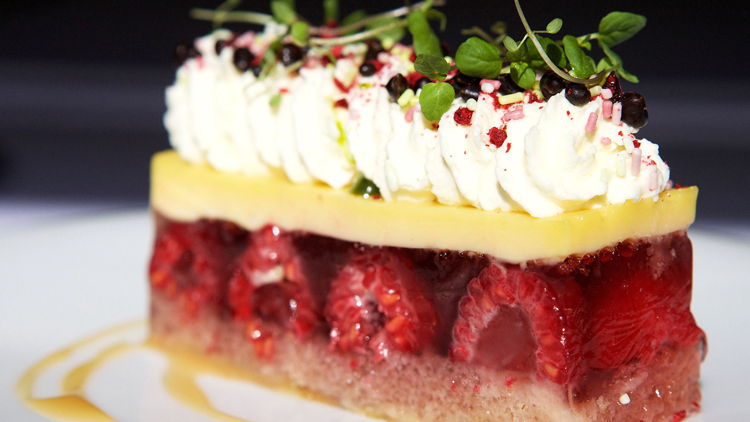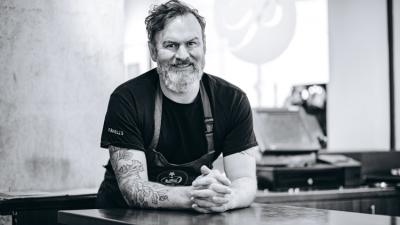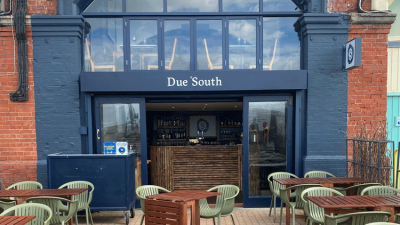TV dinners - the problems with Great British Menu dishes
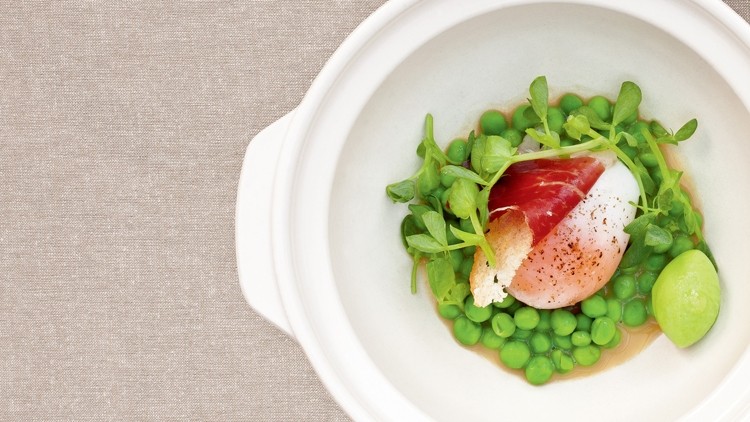
Richard Bainbridge often jokes that the freestanding trifle he created for Great British Menu in 2015 paid for his Norwich restaurant. He is only half joking. Of the 300-odd diners he serves a week, close to 100 will order the trifle.
“Without that dish I genuinely don’t know if I’d still be in business, or as busy as I am. That trifle has been a massive part of me becoming a restaurateur,” says Bainbridge, who opened Benedict’s in the summer of 2015 a few months before the BBC2 show’s season finale.
Named after his grandma, Nanny Bush’s Trifle features on Bainbridge’s à la carte menu and as an option on both his tasting menus. The dish is identical to that served on the popular programme, a traditionally made trifle – genoese sponge, fresh raspberries, strawberry jelly, crème chantilly and a custard spiked with Harvey’s Bristol Cream – topped with hundreds and thousands, popping candy, freeze-dried raspberries and gold dust.
Chefs are cashing in on Great British Menu, which first aired in 2006 and has gone on to become one of food TV’s biggest franchises. The cooking show can also be a recipe for stardom, having propelled many already successful restaurant chefs to household name status, not least Tom Kerridge, Marcus Wareing and Richard Corrigan. A good performance often means book deals, more TV work and - ultimately – bums on seats.
The show has become a shop window for ambitious chefs with viewers travelling the length and breadth of the country to taste what they’ve seen on their TV screens. Most Great British Menu contestants have at the very least dabbled with putting their creations on the menu, while some have gone to town with limited-edition themed menus, hefty prices and tasting menu supplements for dishes that have found success on the small screen.
An oeuf is an oeuf
But these superstar dishes can create headaches for aspiring chefs, too. “Sometimes you feel like Elton John must feel when people ask him to sing Rocket Man. There’s a lot more to his body of work than that, but some people are only interested in the hits,” says Michelin-starred Birmingham chef Glynn Purnell, who had a number of successes during the early days of the show including a perfect score for his burnt English custard surprise in 2008.
“It aired on a Thursday night and the next morning the phone started ringing. People were booking in just to try the dish,” he recalls. “We even had a few people walk through the door and say ‘where’s the egg?’. It was unreal.”
Eight months later, Purnell snapped and took the dish – which sees an egg shell filled with crème brûlée and served alongside marinated strawberries and honeycomb – off the menu. “I’d had enough. I felt like the dish was dragging me down. It was all anyone was interested in. But a few weeks after we dropped it, a Scottish woman came in to try it. When my restaurant manager told her we didn’t serve it any more because I’d had enough of it, she fucking lost it. She claimed she’d driven 200 miles just to try it.”
Purnell relented and made the dish to order. “It was before we had a big team and I was right in the shit running the fish and meat section. Making the dish on the fly was a total fucking nightmare but as I was doing it I realised how important a dish like that is. You’ve got to embrace the popularity.”
Purnell’s three biggest sellers are all now dishes that have featured on Great British Menu: the egg dish, a monkfish dish that references his first experience of a Birmingham balti house, and perhaps most notoriously a clever haddock, egg and cornflake dish that received a less-than-stellar reception on the show. “Prue Leith fucking hated it but everyone still wants to try it. It’s probably our most popular dish now,” he says.
Supplemental income
Sat Bains is another Midlands-based chef to have received a perfect score for an egg dish on the show. Based on onsen tamago (an ancient Japanese egg dish made by slow cooking eggs in hot springs) the dish was created for the 2007 series of the programme and sees waterbath-cooked soft duck eggs served with an emulsion of ham fat, butter, water and a little kombu and topped with a fresh mint and pea sorbet made using a Pacojet.
The menu at Bains’ eponymous restaurant with rooms in Nottingham is one of the country’s most forward-thinking and ambitious, and has changed beyond recognition over the past decade, yet the egg dish remains.
“People want to try a 10-out-of-10 dish. Even now, customers are gutted when we don’t have it on,” says Bains. “We nearly always serve it, but availability is more limited in August because the quality of the duck eggs is inconsistent.”
Unlike Purnell, Bains is more equanimous about having his dish on all the time. “I don’t believe that having it on is at odds with the progressive nature of the restaurant. It remains a dish I’m happy with and it is still representative of our style of cooking at the restaurant in so far as it is an exploration of texture, taste and temperature,” he says.
Bainbridge says the two dishes he cooked on the 2015 series – the trifle and a lamb and Jerusalem artichoke dish called We All Stand For Jerusa-lamb – are in keeping with his style. “There’s nothing complicated about either, they’re both totally doable in the restaurant. Which is just as well because they account for a high proportion of our sales,” he adds.
Bains has offered his egg dish as a supplement on his tasting menu for a number of years. While it’s certainly made him a few quid, he can hardly be accused of profiteering: the dish is priced at £15 – the same as it was in 2007.
“Don’t get me wrong. There probably will be a day when I say enough is enough,” says Bains, who estimates he sells 100 a week. “It’s not hurting me having it on. Our only concern is that it can throw the balance of the tasting menu off because it’s a fairly large dish. We often suggest that people share it between two.”
Punell also attempted to make his three Great British Menu dishes tasting menu supplements but ended up getting hauled over the coals for the practice in a broadsheet restaurant review. “It’s a great idea but I got slammed for it,” he says. “The critic said I tried to charge them extra for a dish I once cooked on a TV programme. As a result, we don’t do that anymore.”
A dish to call one’s own
Pierre Koffmann’s pig trotters. Heston Blumenthal’s Meat Fruit. Thomas Keller’s Oysters and Pearls. Many chefs spend whole careers trying to create and perfect an original dish that becomes synonymous with them and their restaurants and has the power to pull in diners.
Getting featured on a TV programme like Great British Menu can make a dish famous overnight. The tills may ring, but there’s a problem. These dishes usually haven’t been dreamt up with restaurants in mind; they’ve been created to look good on TV and impress the judges. While the judging trio often claim to value simplicity and great cooking above all else, TV requires a narrative and a degree of elaboration. Without these, dishes usually fall flat.
In the heat of filming the show, chefs don’t necessarily consider practicalities such as GP, sourcing and the logistics of serving complicated dishes day in, day out in their own establishments. Michael Bremner, for example, laments the prep-heavy nature of his Grass is Greener, which won main course on this year’s series of Great British Menu.
“It is, in many respects, reflective of my style but it’s a technical dish,” says Bremner, the chef-patron at diminutive Brighton restaurant 64 Degrees. “We brine, braise and smoke the ox tongue before covering it in mustard and rolling it up. The whole process takes over 24 hours and requires a lot of space, which is something we’re short on in our kitchen. The ox tongue is then reheated and glazed with the braising liquor and garnished with pickled vegetables and a single jus-filled ravioli. One of my staff said he hated me for that dish the other day.”
Inspired by Wimbledon, the £21 main-course-sized dish is also somewhat incongruous on his Brighton restaurant’s small plates menu.
But Bremner has another Great British Menu dish that causes his team even more of a headache. Though it didn’t win, the Scottish-born chef’s high concept fish-course received a perfect score from the judges last year. Served on a wine bottle-shaped plate, the dish involves five pieces of cured mackerel, each topped with a different garnish and a rolled up scroll with a poem written on it that pays tribute to a famous Scottish fisherman.
Bremner admits that A Message to The Lode Star is completely out of step with the rest of 64 Degrees’s creative but fairly simple menu. It’s also a complete nightmare to prep for and serve. “I kicked myself for making it so complicated. Prepping the mackerel is a big job in itself but the toppings involve a hellish amount of mise en place. There are over a dozen things to do, including a potato salad, an oyster emulsion, an escabeche and a clam you need to carefully wrap in dashi jelly. It also takes every one of our three sections to get the dish out, too,” says Bremner, who will soon break it to head chef Sam Lambert and the team that the dish is about to make a comeback.
Bainbridge had a big year on Great British Menu in 2015, winning both the starter and dessert, but his early performances on the show were somewhat less assured. In hindsight, he believes he dodged a bullet with some of his more outlandish dishes. “I was young and probably a bit foolish. I first appeared on the show in 2010 and only lasted a week. In 2013, I cooked a dish called What Came First The Chicken Or The Egg, which featured a chicken cooked in an inflated cow’s bladder, dyed red. I was cooking at Morston Hall (also in Norfolk) at the time and a lot of people wanted to try it.
"That made we realise the power of the show but to some extent I’m glad I didn’t get that far on that series either because that dish wasn’t me at all.”
Seasonal changing dishes
Understandably, most customers want to try dishes exactly as they appear on the show. At Benedict’s, Nanny Bush’s Trifle is currently served all year round, which means sourcing the strawberries and raspberries from far-flung destinations for much of the year.
“That’s something we’re going to change because it does not fit with the ethos of the restaurant,” says Bainbridge. “We’re going to start using fruit that’s appropriate for the time of year. I want to cook seasonally and I also want to keep things exciting for the team.
“The lamb dish is trickier because if you lose the Jerusalem artichokes you lose the whole point of the dish. Sometimes we pay a fortune to get them out of season and sometimes they’re just not available and we take the dish off. It’s been a couple of years now so I often think about taking it off for good but then someone asks for it or we get an email. I guess we’ll take it off when people stop asking for it.”
If Bains and Purnell’s experiences are anything to go by, he might be waiting a while. Chefs are conflicted. On the one hand they don’t want to cook the same dish year in, year out or be accused of dining out on past glories, on the other it makes little sense to drop a dish that makes diners beat a path to their restaurants.
“Every now and then I have another wobble and start to consider taking it off,” says Purnell. “But I’m 42 now and I’ve got kids to feed. Gone are the days I throw pans at the wall and say ‘fuck the customer’. Perhaps they’ll carve it on my tombstone: ‘Here lies the man that put crème brûlée inside an egg shell. May he rest in peace’.”
This is a web version of an article that rst appeared in the October issue of Restaurant magazine, the leading title for the UK's restaurant industry. For more features, comment, interviews and in-depth analysis of the restaurant sector subscribe to Restaurant magazine here.
